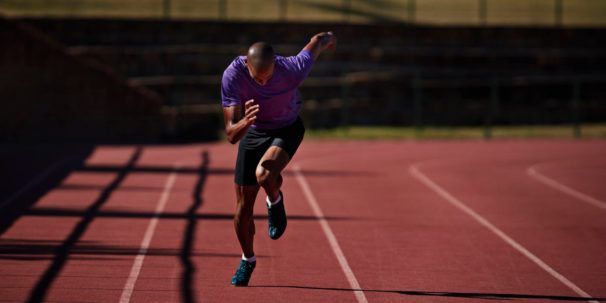How to train like an athlete – simple steps for exercising efficiently
We explore what makes a top athlete and how you can focus on training, nutrition, coaching and psychology to perform at your peak.

Although the Olympics will be a bit different this year, what’s certain is that we’ll see some of the world’s top athletes compete. But what makes these individuals and teams able to perform at such a high level? We take a look at how to train like an athlete.
As well as exploring how top athletes train, we also explore some of the other key areas they must focus on. Nutrition, coaching, and psychology can all play a role in making an elite athlete.
What makes an athlete?
Let’s start by looking at the meaning of the word athlete. We’re all mostly familiar with the fact that they’re sportspeople, but it’s worth digging deeper into a definition.
There are actually several ways of defining an athlete. The word comes from the Greek athlētēs, meaning ‘contestant in the games’. The modern athlete meaning has changed somewhat, although an element of competition is often still present.
These days, we often consider athletes as those who train for and are skilled in a range of exercises, sports, and/or games that require some combination of physical strength, agility, and stamina.
It’s easy to think of only the pro athletes that compete at the top of their field. However, in reality, it’s not just the professional sportspeople who can be athletes. Anyone who trains for and competes in a sporting event has at least some characteristics of an athlete.
The characteristics of top athletes
When we think of some of the characteristics that professional athletes often show, it can be difficult to know where to start. After all, the term itself encompasses a wide range of sports, disciplines, and skills. Physically, there is a wide variety of builds and strengths even within certain areas.
For example, the most successful and most decorated Olympian of all time, US swimmer Michael Phelps, has a very different physical build to footballer Lionel Messi. Similarly, the skills of tennis star Venus Williams are different to those of British Paralympian Dame Sarah Storey. Yet all of these are top athletes in their respective fields, setting records and winning trophies.
However, let’s take Michael Phelps as an example. At his peak, he was clearly physically strong and fit. What’s more, many people point out certain aspects of his physiognomy that make him unique (such as ‘flipper-like’ feet, double-jointedness, and reduced production of lactic acid). Yet these features alone don’t make an athlete – his ability, training, technique, hard work, focus and dedication were all essential.






Physical aspects
Various studies have tried to find out what, on a physical level, makes a top athlete. For example, one study from 2013 looked at the difference between endurance and field sport athletes.
The researchers found that, in anaerobic (more intense, but shorter) field and court sport athletes, maximal power output is most predictive of elite performance. However, for endurance athletes, the picture is not as clear. They found that elite endurance athletes:
- Consistently test higher than non-elite athletes in running economy,
- Have a higher anaerobic threshold (the point at which lactic acid starts to build up quickly in the blood)
- Have a higher VO2max (essentially their cardiorespiratory fitness. It’s a number that shows how effectively the heart, lungs, circulatory system, and muscles work, individually and together)
Psychological aspects
When looking for the characteristics of the best athletes, a 2017 study from researchers at the University of Portsmouth and the University of Bath in the UK provided some potential answers. They examined the mindsets of some of the most elite athletes, coaches, and sports psychologists, to find out the traits of top athletes. These include:
- Desire and motivation
- Commitment to excellence
- Concentration
- Self-belief
- Goal-setting
- A positive state of mind
- High-quality relationships
- Support from others
Clearly, both psychological and environmental factors play a huge role in success. As the author of the study, Dr Daniel Brown, points out, this could show why some of those who are gifted at sport don’t succeed at an elite level.
Why train like an athlete?
Before we get into the details of how to train like an athlete, let’s first look at why you’d want to do so. Whether you’re hoping to gain a competitive edge or simply looking to get into better shape, taking inspiration from top athletes can bring all kinds of benefits.
The power of regular exercise can impact both your physical and your mental health. And, no matter whether you’re a total beginner or experienced in your field, having focus, commitment, self-belief and goals can help you in various aspects of life.
Physical benefits
As we explore in our open step on the benefits of physical activity, keeping active on a regular basis can bring all kinds of benefits to your physical health, including:
- Helping build and maintain bones, muscles, joints
- Controlling weight, building lean muscle and reducing fat
- Preventing high blood pressure
- Reducing your risk of major illnesses, such as heart disease, stroke, type 2 diabetes and cancer by up to 50%
- Lowering your risk of early death by up to 30%
Mental health benefits
We’ve already seen that the best athletes are often those who have a positive mental attitude. However, the reverse is also true – doing exercise can help with your mental wellbeing. Benefits include:
- Reducing stress
- Improving mood
- Thinking more clearly
- Boosting self-esteem
- Improving sleep quality
- Increasing your energy
- Reducing your risk of depression, dementia and Alzheimer’s disease
What types of athletes are there?
As you’ll see, it’s impossible to create a one-size-fits-all athlete training program. Similarly, it’s hard to separate sportspeople into different ‘types’. It’s a better idea to look at some of the different sporting disciplines and think about the different strengths needed to succeed.
If we look at the Olympic sports for the Tokyo 2020 Olympics, medals will be awarded across 339 events, which represents 33 different sports. Across the various sports and disciplines, there are all kinds of different skills, strengths, and abilities on display.
As you can imagine then, there are all kinds of ways to train. If you’re just starting out with exercise, it can be confusing to know where to begin. Similarly, if you already have some athletic ability, it’s not always easy to hone and direct your efforts.
Whether you want to focus on areas such as strength, speed, power, endurance, agility, coordination, flexibility, balance, or other areas, taking inspiration from the best athletes can certainly help.
How to train like an athlete
So, how do athletes train? As we’ve established already, this depends on a lot of factors. Let’s take another Olympic Champion as an example. British cyclist Laura Kenny outlined in an interview that the cycling team does a mixture of gym, road, and track cycling throughout a week, training for around 15-20 hours.
Clearly, this is an elite level of training. The average person likely doesn’t have the time to dedicate such long hours to exercise. However, that doesn’t mean you can’t follow some of the principles that top athletes follow.
It’s worth pointing out that this is a general outline. It’s not advice or a dedicated training programme – it provides a starting point for further research and learning. What’s more, bear in mind that professional athletes will usually have an entire team of people to help with their training – a luxury that most of us don’t have access to.




Training
All athletes, whether professional or amateur, must train. Even with all the natural talent in the world, training is essential. So how do you go about exercising like an athlete? Here are some tips to get you started:
Set goals
In our open step on how to set effective goals, we look at the five principles of goal setting as outlined by Dr Edwin Locke and Dr Garth Latham. They proposed that goals should:
- Be clear
- Provide a motivating amount of challenge
- Have the commitment of the person setting them
- Take feedback on progress into account (so that changes can be made to goals if necessary).
- Take into account the complexity of the tasks required to achieve them.
So, whether you’re training for a triathlon, competitive event, or even your first 5K run, having goals in mind can be a great place to start.
As well as your overall goal, you should also come up with some milestones along the way. You’re not going to be marathon-ready without gradually building up to it.
Create or follow a training programme
Whatever your goals are, you’ll need a training programme that’s going to help you achieve them. You’ll find that there are many exercise routines out there, varying in levels of complexity.
It’s worth finding one that works for your needs and style of training. You might want one that gradually builds you up to your target, such as Couch to 5K, or maybe one that helps you make incremental progress, such as StrongLifts 5×5.
Do your research to find one that meets your expectations, lifestyle, and ability. Alternatively, you can create one yourself based on your findings.
Routine
Having a regular routine is another crucial part of training like an athlete. It helps you keep up with your training programme and on course with your goals. Your routine may also keep you ticking over with exercise, even when your motivation fails.
You’ll often see that elite sportspeople have daily routines, focused around training and eating (more on that later). While you don’t necessarily have to dedicate your entire day to exercise, having regular slots that work around your daily schedule can help. For example, a cycle on your lunch break or a regular gym session after work.
Train the right areas
When we think about the ‘right’ areas to train, it depends a great deal on your goals and sport. For example, you’ll want to perfect your technique, as well as building the muscles and stamina to support that.
However, it is important to exercise your whole body. Even if (like most of us) you’re not a professional athlete, the NHS recommends being active on a regular basis, including:
- Aiming to be physically active every day
- Doing strengthening activities that work all the major muscles (legs, hips, back, abdomen, chest, shoulders and arms) at least 2 days a week
- Performing at least 150 minutes of moderate-intensity activity each week (or 75 minutes of vigorous-intensity activity each week
- Reducing time spent sitting or lying down, breaking up long periods of not moving with some activity.
Know your limits
Although exercise is fantastic for your physical and mental wellbeing, there is such a thing as too much. It’s important to recognise your physical limits, as too much exercise can result in exhaustion, injuries, and even worse mental health.
Although pushing yourself to extend your limits can be rewarding, it’s essential to do so in a way that maintains your health, preferably in consultation with a professional.
Nutrition
Athlete nutrition is one of the cornerstones of any training regime. At the most basic level, the food we eat provides the energy required to perform at our peak. Sports nutrition is a whole industry in itself, which can make things confusing. However, there are ways you can go about making sure your nutrition matches your training:
Understanding food
The first step in making sure you’re eating the right things is to understand food and how it impacts your body. With one of our courses, you can discover the link between food, exercise and the gut, as well as explore how to improve mental health through diet.
Understanding how nutrition and wellbeing are linked can help you make informed choices about what you eat when you’re training.
Adjusting your diet
As you begin to appreciate what an athlete eats, you can then start to adjust your own diet according to your training plan. This could mean that you learn about healthy cooking or find out the myths and truths about superfoods.
Remember, there are many diet fads out there that promise all kinds of results. Yet it takes knowledge and effort to eat in a way that will support your training. If you’re unsure, you can speak with a qualified professional for further details.
Coaching
When we looked at the characteristics of top athletes, two areas, in particular, went beyond just the individual. The most successful sports stars often cite high-quality relationships and support from others as an essential part of their training. Here are some points worth considering:
The importance of help
It’s clear that having close relationships and support is crucial to athletic success. The coach-athlete relationship can take many forms, whether it’s a one-on-one or more group-focused setting.
In our ExpertTrack on sports coaching and leadership, you can learn about the ways in which concepts from sports psychology, coaching and leadership can be applied to teams and athletes in a number of contexts.
The role of a coach
As we explore in our open step on sports coaching, we look at the ways in which coaches help Paralympic swimmer Monique Murphy. Her various coaches have helped her with her swimming technique and strength.
Coaches use their experience, education, and a desire to continually improve athletes to keep them motivated and training in the right ways. If you’re looking to train like an athlete, finding a good coach could be an option worth exploring.
Psychology
Another key area of training like an athlete is the mental preparation and outlook that’s needed. Again, referring back to the characteristics of top athletes, certain aspects stand out. Desire and motivation, a commitment to excellence, concentration and self-belief, all play a role.
Here are some considerations and tips for working on these areas:
Mental training
Sports psychology can help you to improve physical performance in yourself or others. With our course, Mental Skills Training for Sport and Health, you can learn how psychological training techniques enhance athletic performance.
You can learn how to use mental practice to improve concentration, control emotional responses, acquire and practice strategy, and cope with pain and injury. All of these can help as you get underway with your training.
Confidence
Self-belief and confidence are a hallmark of top performers. If you believe in your ability to succeed, reach goals, and improve your abilities, you’ve won half the battle. Our open step on understanding self-confidence explores some of the key principles of the subject.
As you find your rhythm and apply all of the other aspects of successful training, you may even find that your confidence grows naturally.
Final thoughts
Hopefully, you’ve discovered some useful tips about how athletes train and how you can apply them to your own routine. Whether you simply want to keep fit or push yourself to be more competitive, having the right physical and psychological approach can certainly help.
With our range of coaching courses, you can find out how you can improve your own abilities, as well as those of others. Similarly, learning about areas such as nutrition and psychology can play a central role in your training regime.




